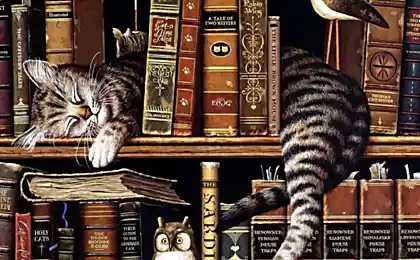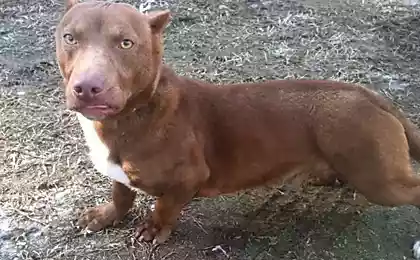791
Where there have been taxes
Some people know that I have two dachshunds live stragglers. After watching this video about a hare, I thought - and in fact if you raise your hands ears fees will be the spitting image of a hare, but the long and the tail.
I decided to dig a little deeper, and that's what found
via google

Taxis can be considered as probably one of the most unusual dog breeds. It is hard to find in the wild wolf family member with a long body with short, curved in the form of the letter Z limbs. The shape of the body resembles a fee rather animals of the weasel family.
The origin of fees is not known; in this regard, there are rather contradictory opinions. Some believe that taxes are descended from wild bow-legged dog that once existed in the mountains of Germany.
For others, the fee - is one of the oldest surviving breeds of hunting dogs, whose roots should be sought in ancient Egypt.

The first European sources, which describes the appearance of modern taxes, there are more than 2 thousand. Years, and date back to when we lived and worked the famous ancient Greek historians and writers - Xenophon (about 430-355 years. BC. E.) And Arrian (between 95-175 gg.).
In his book "Kinegetik" Xenophon tells some detail about hunting dogs, their working qualities and mannerisms, he mentions dogs, similar to a taxi, and in the extant writings of Arrian has a treatise on hunting, which appear and beagle.

We know (someone) that the fee is derived from Bracco, presenting his mutated dwarf forms. Bracco also known for his work on the surface.

Despite the fact that the fee is known in Russia since the 30s of the XVIII century, a large spread among the masses it has not received. However, the breed was popular enough so that in 1900 there was Russian society lovers fox terriers and dachshunds, who led the herd books and organize special exhibitions.
Oddly enough, but the inhabitants of the Russian state fee was regarded more as a decorative dog, but not working.
Many families keep this breed as a domestic pet.
Very fast and successful rate spread among the intellectuals. In the great Russian actress MN Yermolova fee was unusual for this breed of white color.
In AP Chekhov had two dachshunds (Bromine Isaichev Hina Markovna). Anton Chekhov once wrote to his publisher, AS Suvorin: "I have news: two dachshunds - Bromine and Hina, ugly-looking dog. Paws curves, long body, but the mind is extraordinary. "
So the sensible dog took over Russia.

According to the classification FCI, fees are 3 types of wool:
gladkoshёrstnyedlinnoshёrstnyezhestkoshёrstnyeTakzhe released 3 type sizes. Dogs are measured in accordance with the rules not so much by weight as by volume (circumference) of the chest:
Standard fees - from 35 smkarlikovye fees - 30-35 smkrolichi fees - up to 30 smTakim way, there are 9 species of taxes.

I have a standard, according to the classification and clever bastards)))
That's all. Thank you all, taxes will go for a walk))
PS Oh, and someone heard about this same breed Bracco? To be honest, the first time he learned ...

Source:
I decided to dig a little deeper, and that's what found
via google

Taxis can be considered as probably one of the most unusual dog breeds. It is hard to find in the wild wolf family member with a long body with short, curved in the form of the letter Z limbs. The shape of the body resembles a fee rather animals of the weasel family.
The origin of fees is not known; in this regard, there are rather contradictory opinions. Some believe that taxes are descended from wild bow-legged dog that once existed in the mountains of Germany.
For others, the fee - is one of the oldest surviving breeds of hunting dogs, whose roots should be sought in ancient Egypt.

The first European sources, which describes the appearance of modern taxes, there are more than 2 thousand. Years, and date back to when we lived and worked the famous ancient Greek historians and writers - Xenophon (about 430-355 years. BC. E.) And Arrian (between 95-175 gg.).
In his book "Kinegetik" Xenophon tells some detail about hunting dogs, their working qualities and mannerisms, he mentions dogs, similar to a taxi, and in the extant writings of Arrian has a treatise on hunting, which appear and beagle.

We know (someone) that the fee is derived from Bracco, presenting his mutated dwarf forms. Bracco also known for his work on the surface.

Despite the fact that the fee is known in Russia since the 30s of the XVIII century, a large spread among the masses it has not received. However, the breed was popular enough so that in 1900 there was Russian society lovers fox terriers and dachshunds, who led the herd books and organize special exhibitions.
Oddly enough, but the inhabitants of the Russian state fee was regarded more as a decorative dog, but not working.
Many families keep this breed as a domestic pet.
Very fast and successful rate spread among the intellectuals. In the great Russian actress MN Yermolova fee was unusual for this breed of white color.
In AP Chekhov had two dachshunds (Bromine Isaichev Hina Markovna). Anton Chekhov once wrote to his publisher, AS Suvorin: "I have news: two dachshunds - Bromine and Hina, ugly-looking dog. Paws curves, long body, but the mind is extraordinary. "
So the sensible dog took over Russia.

According to the classification FCI, fees are 3 types of wool:
gladkoshёrstnyedlinnoshёrstnyezhestkoshёrstnyeTakzhe released 3 type sizes. Dogs are measured in accordance with the rules not so much by weight as by volume (circumference) of the chest:
Standard fees - from 35 smkarlikovye fees - 30-35 smkrolichi fees - up to 30 smTakim way, there are 9 species of taxes.

I have a standard, according to the classification and clever bastards)))
That's all. Thank you all, taxes will go for a walk))
PS Oh, and someone heard about this same breed Bracco? To be honest, the first time he learned ...

Source:























